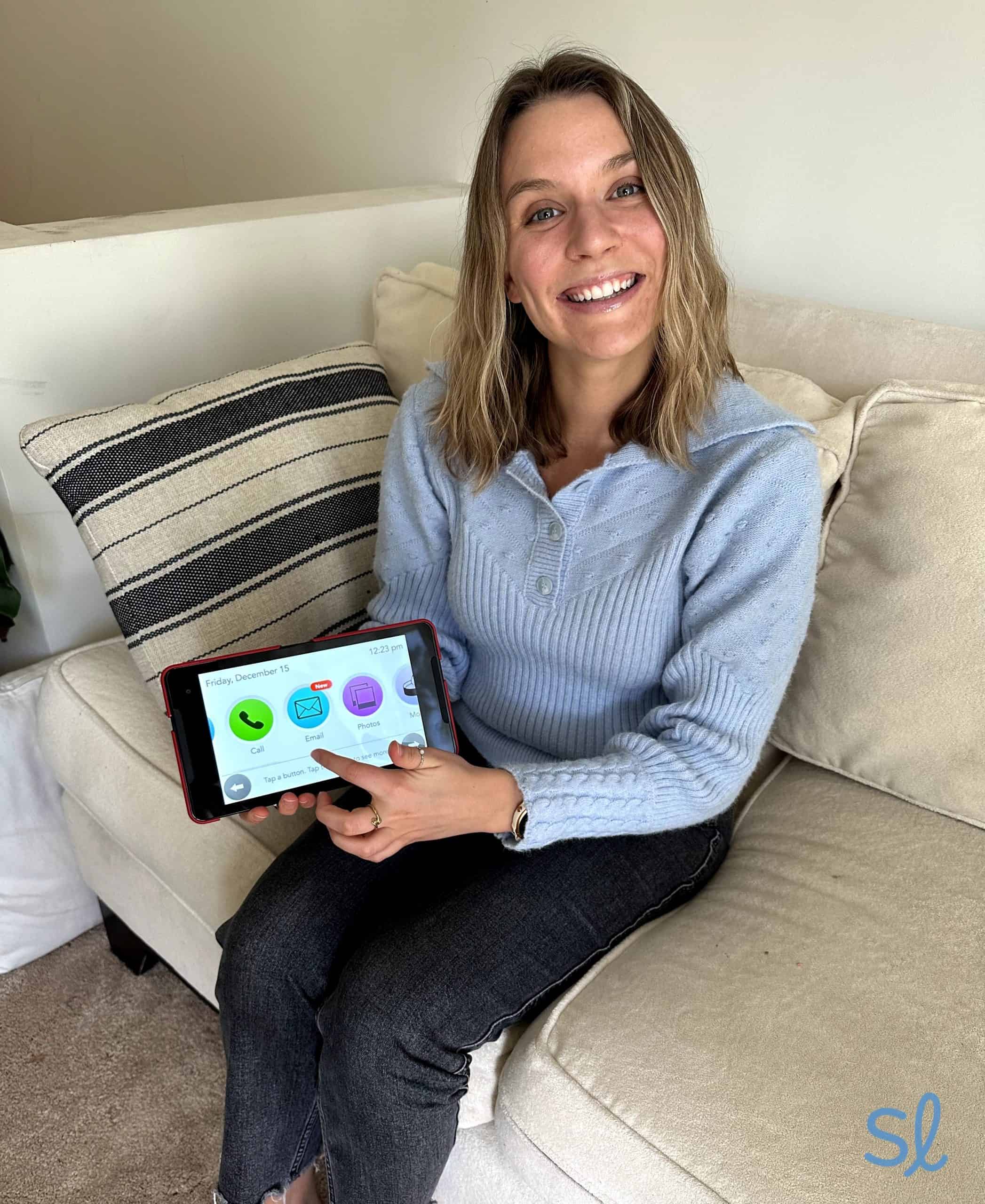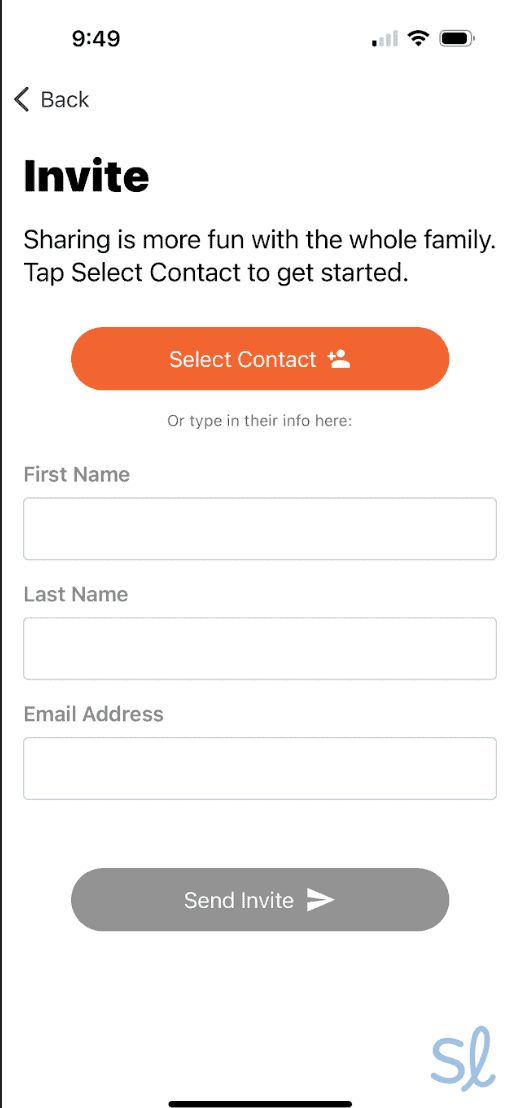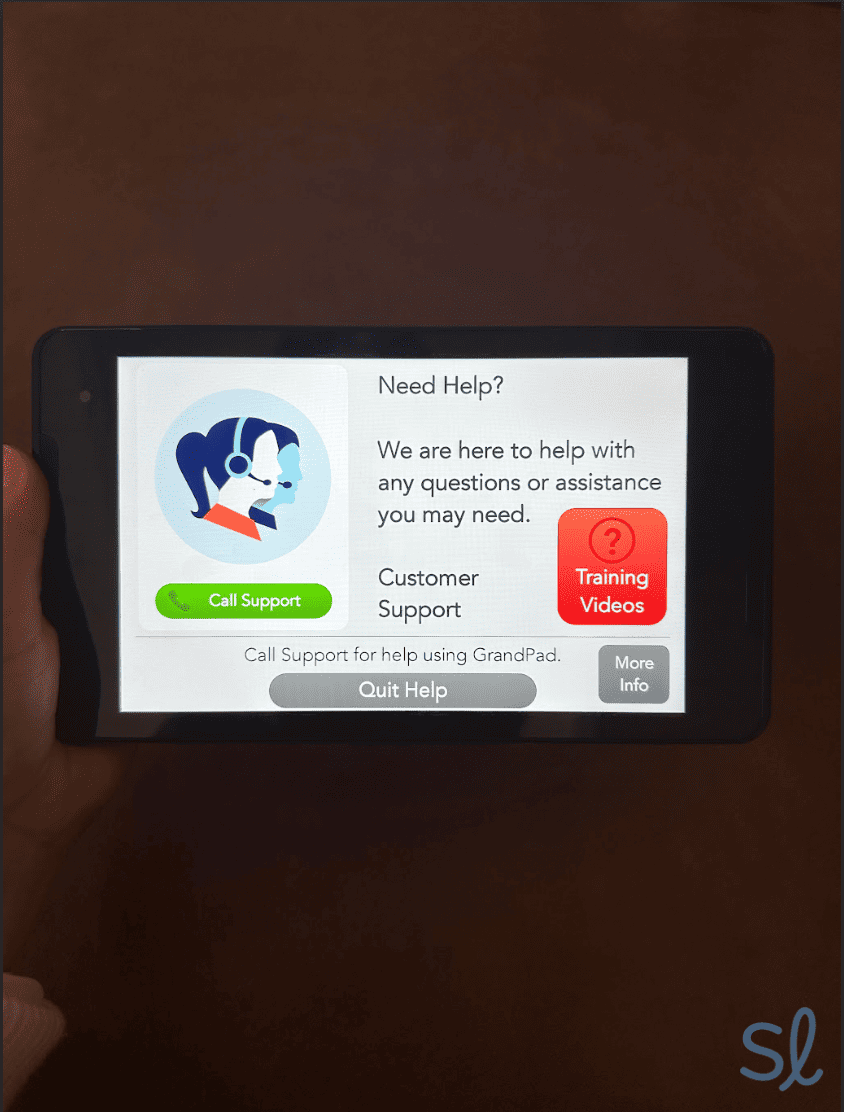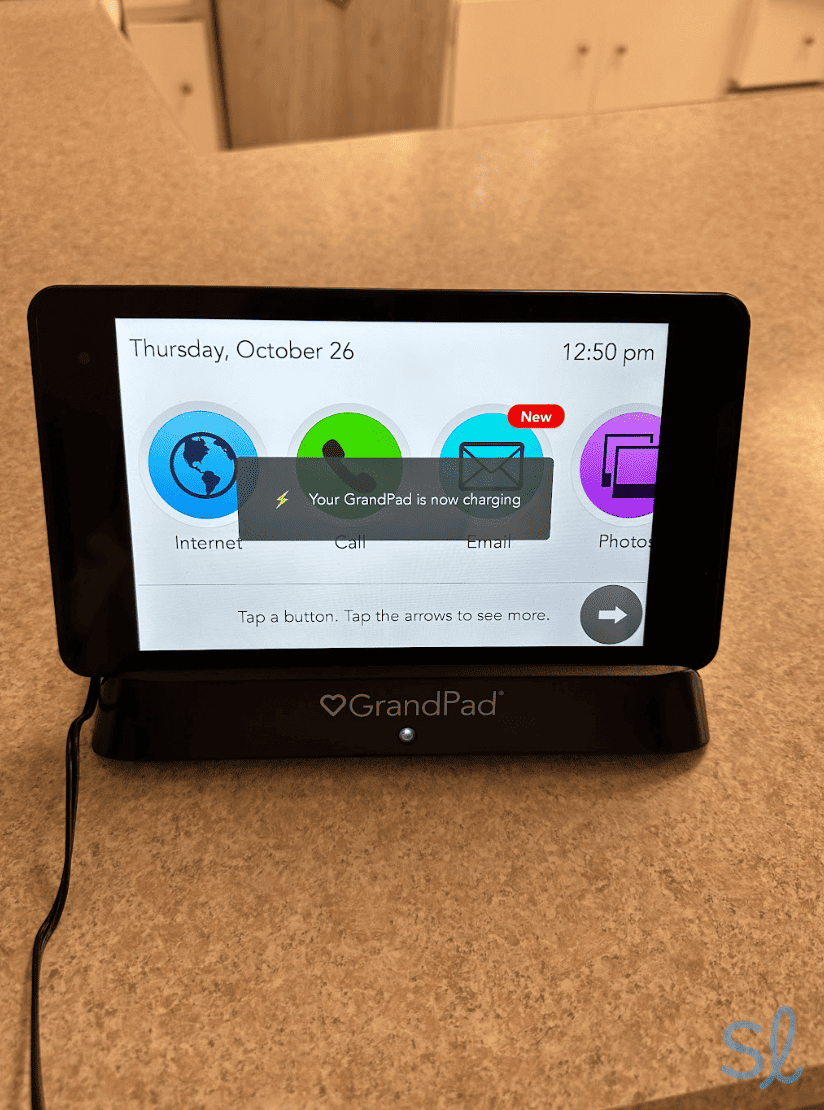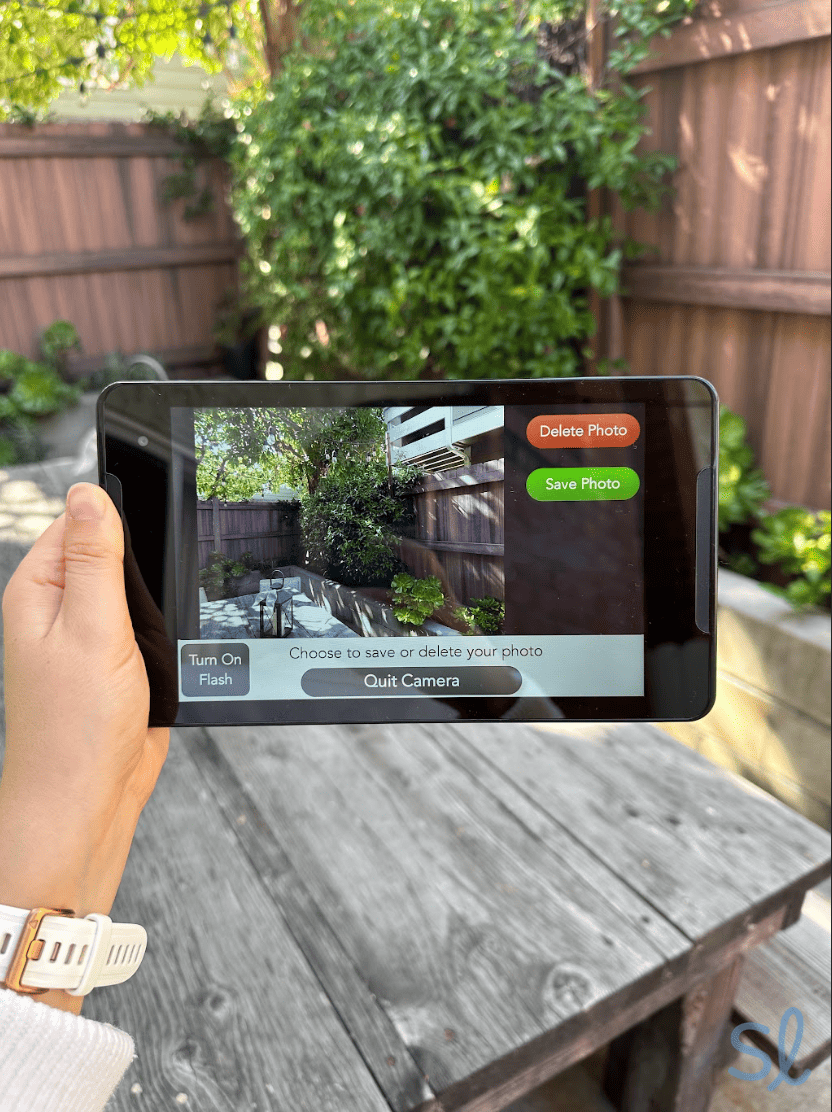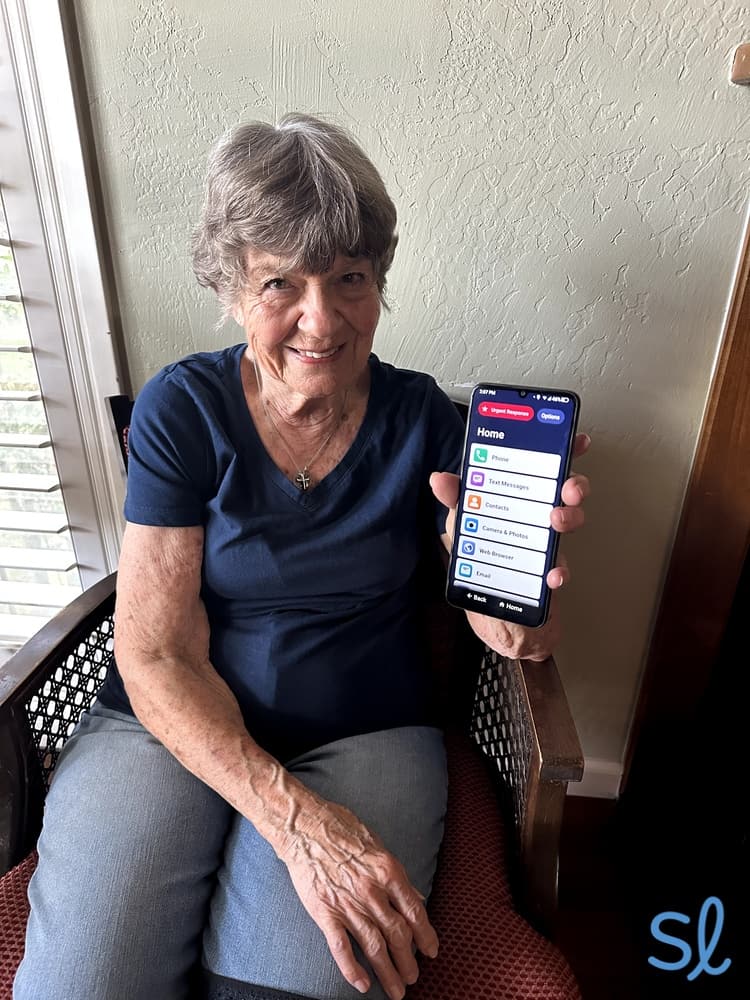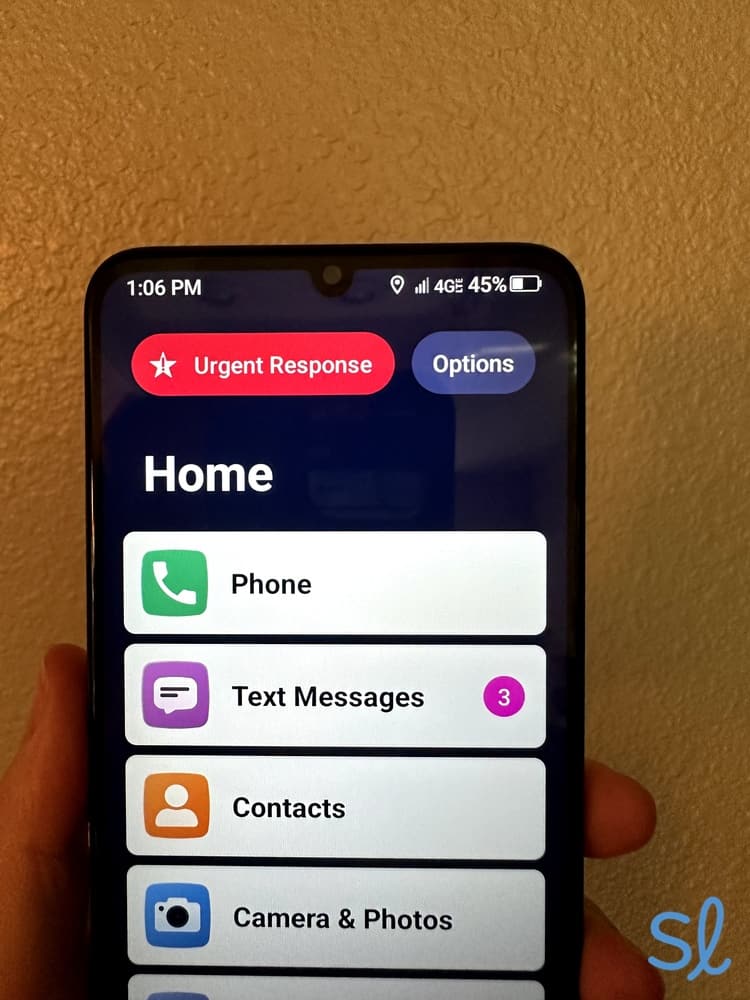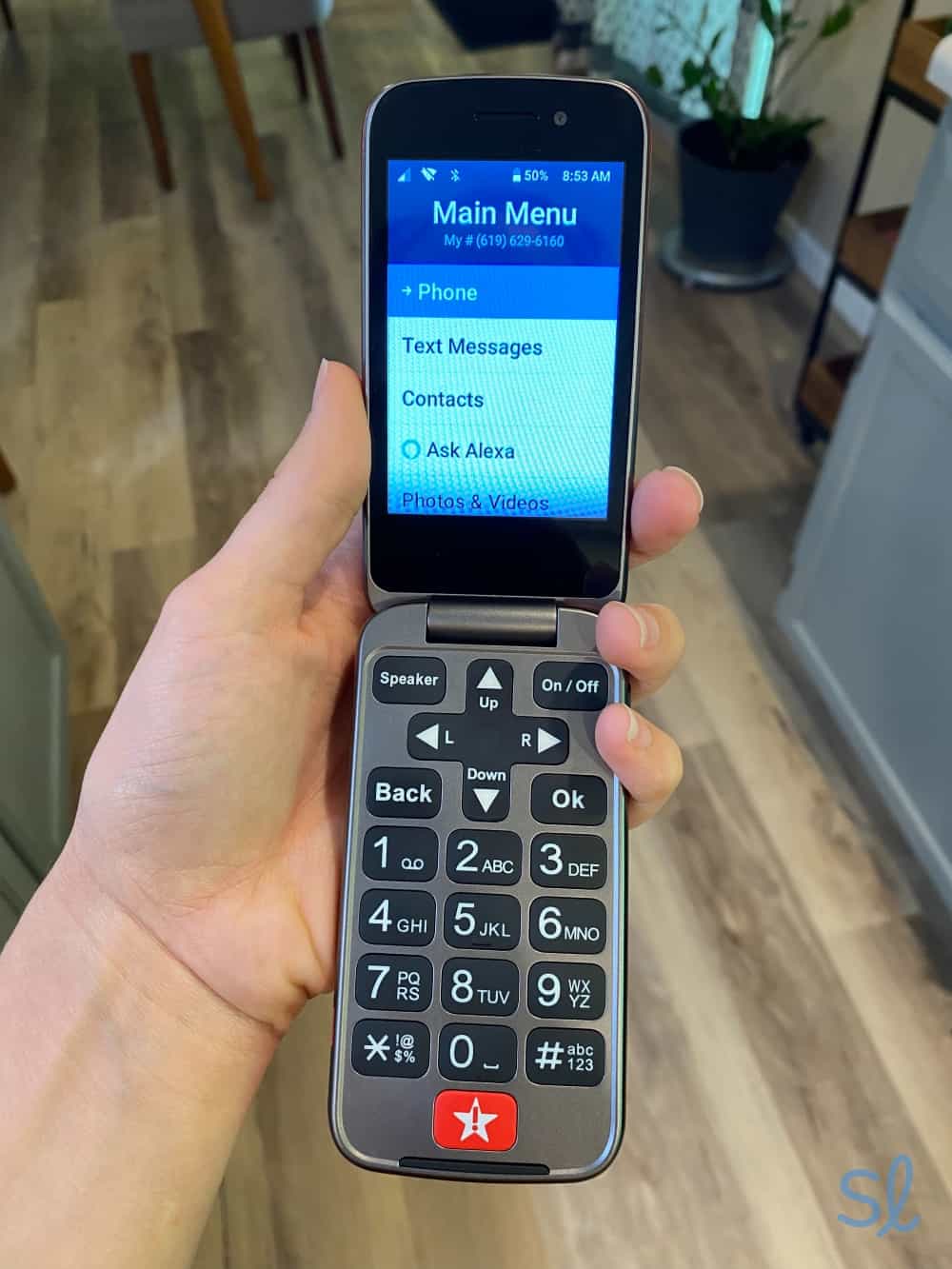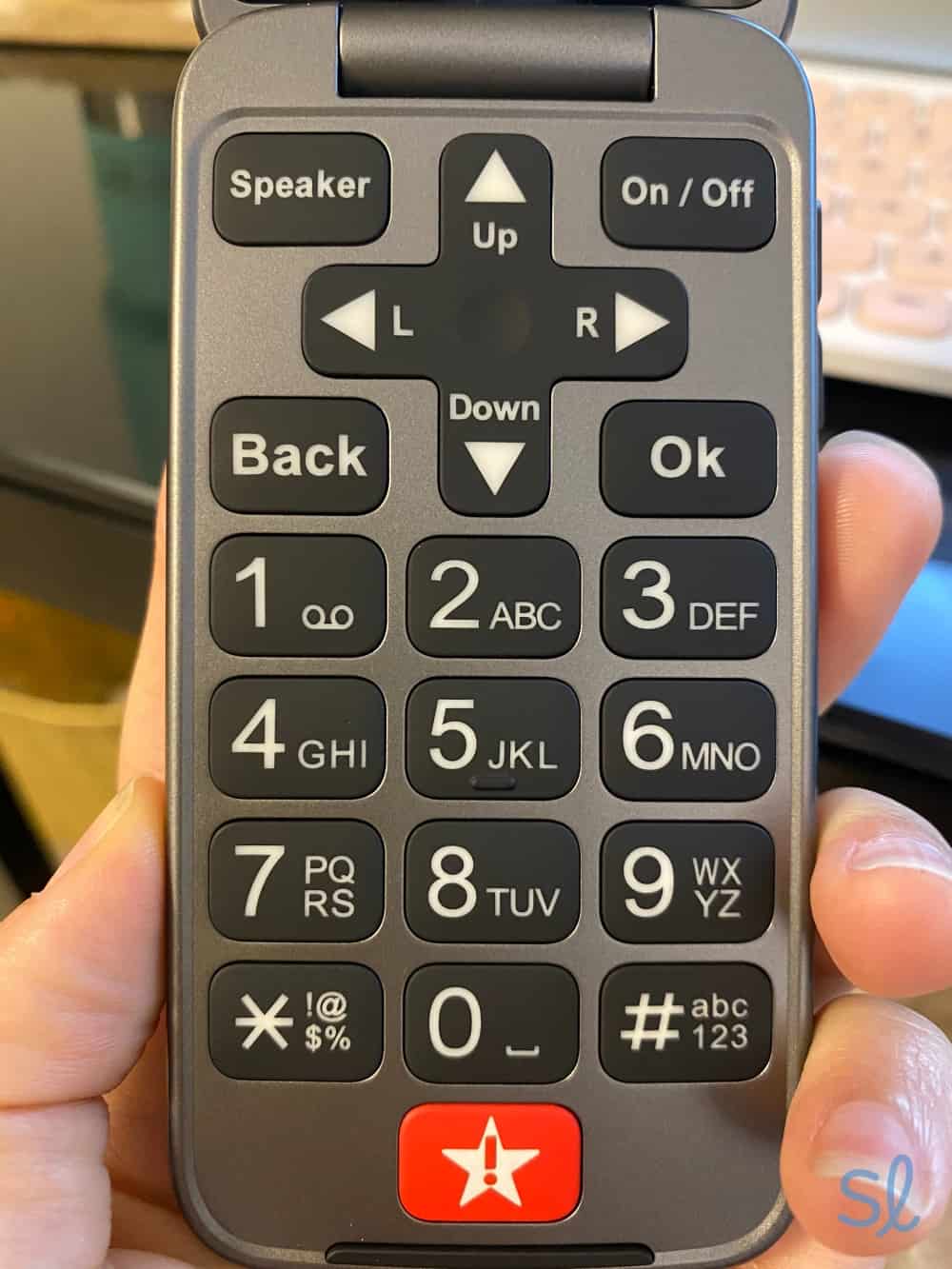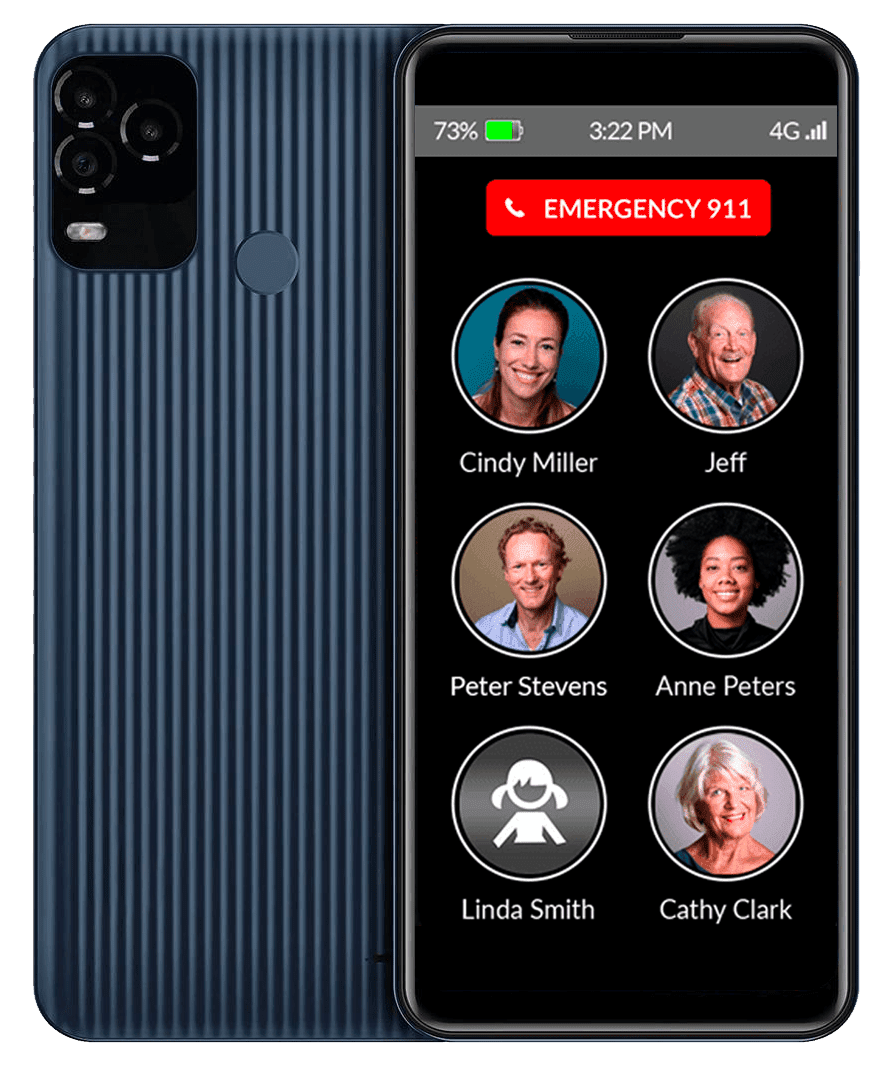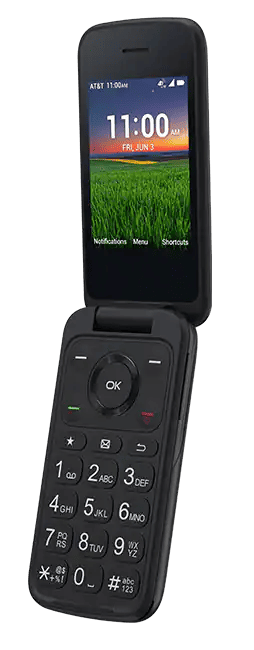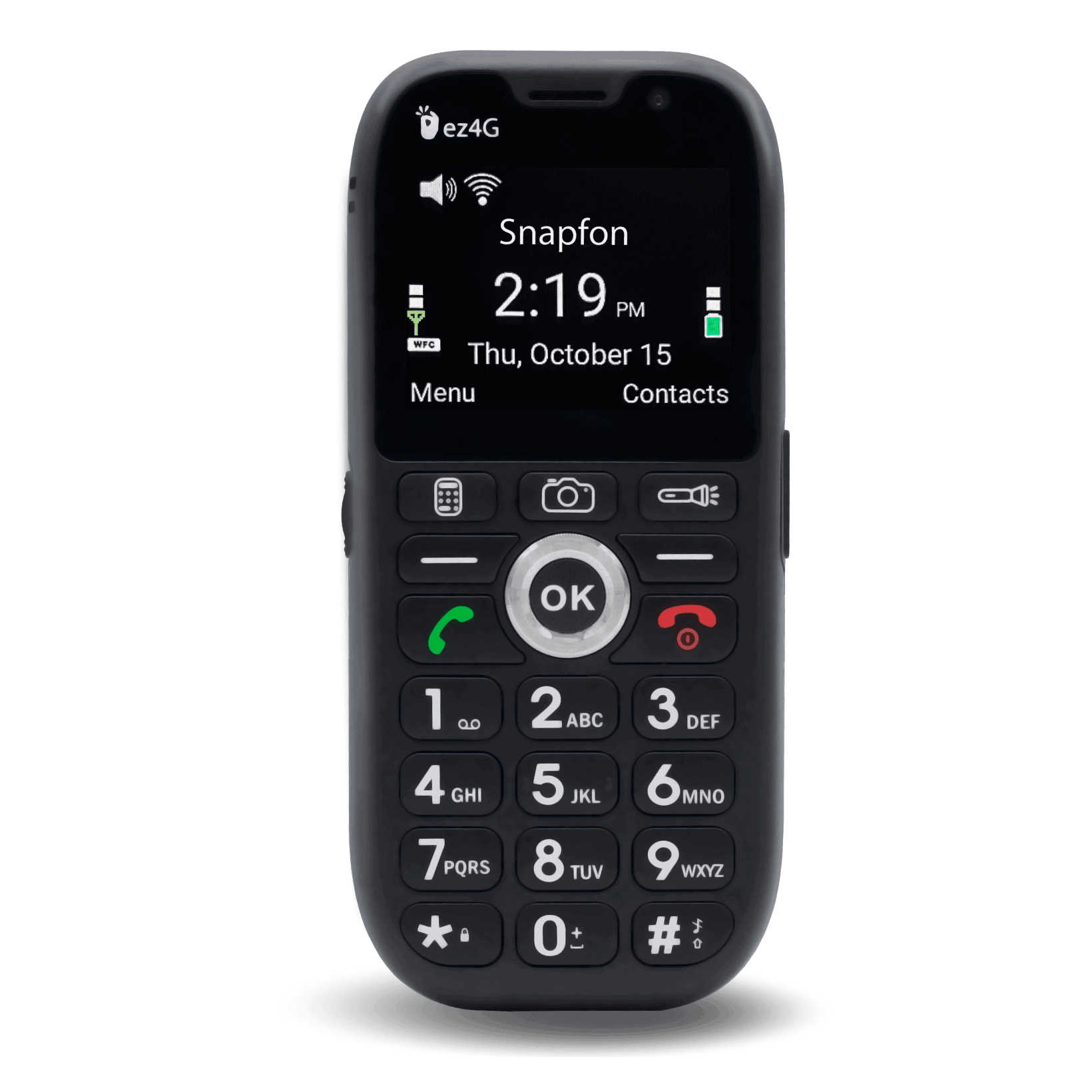The Best Cell Phones for Seniors With Dementia, Tested and Reviewed by Tech Experts in 2025
Our tech experts’ top picks for cell phones for those with dementia in 2025 offer key features such as easy-to-navigate menus, affordable prices, and security features.
SeniorLiving.org is supported by commissions from providers listed on our site. Read our Editorial Guidelines
- Tablet designed for seniors
- Large, descriptive icons and buttons
- Unique features: Closed family network for optimum security and privacy
- Smartphone designed for seniors
- Large buttons and list-style menu
- Unique features: Built-in medical alert features
- Flip phone designed for seniors
- Built-in medical alert features
- Large buttons and list-style menu
- Designed for those with memory loss
- Simple, one-screen design
- Caregiver features
- Medical alert features
- Affordable phone
- Simple design
Our senior tech experts tested and compared the best cell phones on the market and narrowed down the list to our recommendations for those with dementia.
Our senior tech experts tested and compared the best cell phones on the market and narrowed down the list to our recommendations for those with dementia.
Learn MoreContents
Because dementia affects cognitive abilities, staying connected poses its own challenges. That’s why the right cell phone is a must for both safety and communication. Our tech experts spent 100 hours researching and testing the best phones for those with dementia to put this guide together.
Consumer Cellular’s GrandPad is our top solution for those with dementia thanks to its large screen, easy-to-navigate menu, and closed family network for security. Lively offers our favorite flip phone and smartphone for seniors. Lively’s Jitterbug Smart4 and Jitterbug Flip2 are both easy to use and offer a variety of health and safety features. Read on to learn more about our top picks.
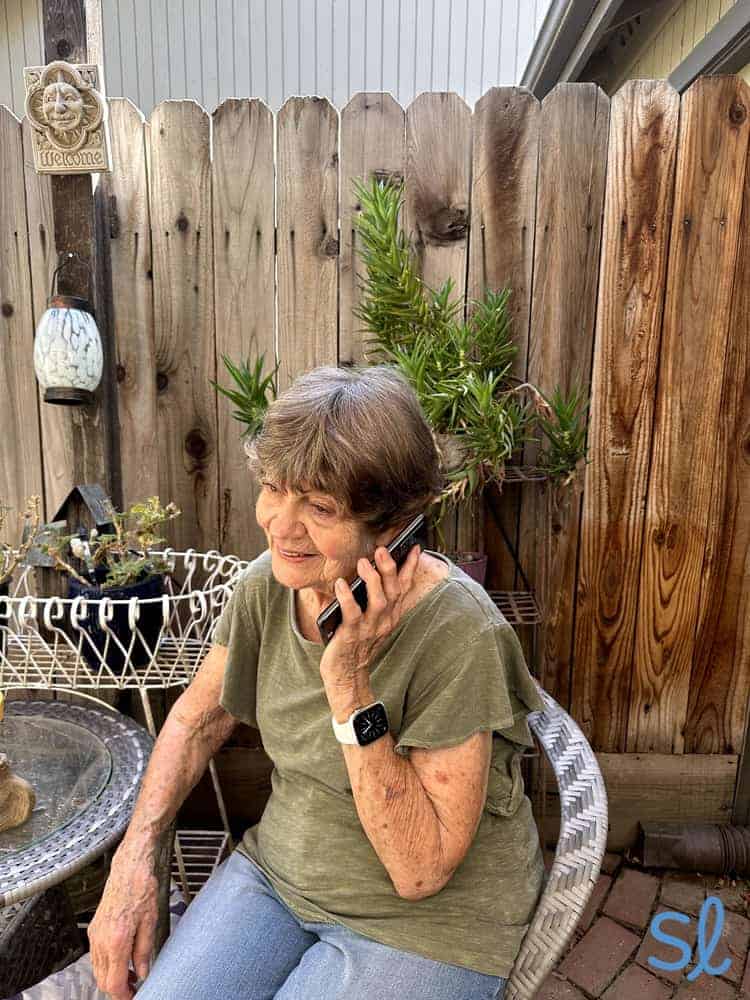
Making a call on the Jitterbug Smart4

Our Methodology
How We Tested the Phones
Our tech team and I identified 15 of the top phones for seniors with dementia based on the criteria below. Then we tested each phone to narrow down the list to the best phones. To ensure a thorough testing process, we tried each phone using these steps:
- We researched each of the phones and their compatible cell phone plans. Then we chatted with customer service and purchased each device.
- Once we received each phone, we unboxed it and set it up.
- We used each phone for a few days, taking notes on things we liked and didn’t like. We evaluated each phone’s quality, useful features for those with dementia, battery life, camera quality, service reliability, durability, value, and more. I also asked my grandma for feedback. She doesn’t have memory loss, but this gave us a mor
- We compared our experience with all the phones and narrowed down our list to the devices that were the best fit for seniors with dementia.
How We Chose the Best Phones for Seniors With Dementia
The cell phones that made our list met specific criteria selected by our tech team after 100 hours of research and hands-on testing. To make the cut, each cell phone had to meet the following requirements:
- Useful features: The phones on this list are not only senior-friendly, but also useful specifically for seniors with dementia, with features such as easy-to-navigate menus, voice assistants, medical alert capabilities, and long battery life. We also looked specifically at camera quality, because photos can be a great way to help seniors remember important information or special moments.
- No contracts: If you’ve been a SeniorLiving.org reader for even a short time, you probably know we’re not fans of long-term contracts. All the phones on our list have month-to-month payment options, so you can cancel at any time for any reason without facing fines.
- Bang for your buck: Every senior has a different budget, so we’ve included both inexpensive and pricier options. Whatever the price point, you can rest assured that each of the phones we recommend offers solid value.
Why Trust Us
Our senior tech experts try the latest tech for older adults. We’ve spent hundreds of hours testing and reviewing cell phones and plans for seniors. We consult with older adults to learn about their experiences with different phone models, including what they like, what they dislike, and features they think could make the phone even more helpful for seniors with memory loss.
-
1. Consumer Cellular GrandPad - Best Tablet
 See Pricing Links to Consumer Cellular GrandPad
See Pricing Links to Consumer Cellular GrandPadWhat we like most
- Tablet designed for seniors
- Large, descriptive icons and buttons
- Unique features: Closed family network for optimum security and privacy
 Consumer Cellular GrandPadSee Pricing Links to Consumer Cellular GrandPadOverview:
Consumer Cellular GrandPadSee Pricing Links to Consumer Cellular GrandPadOverview:Using the GrandPad tablet from Consumer Cellular
Tablets like the GrandPad offer larger screens for reading, watching videos, playing games, and video chatting with family and friends. A bigger screen makes it easier to text and see everything, especially for people with vision loss.
» You Might Like: The Best Cell Phones for Seniors With Vision Loss
If you like your screens extra large, then Consumer Cellular’s 8-inch GrandPad fits the bill. The jumbo pad also has big, colorful app icons that are very easy to see. All of the GrandPad’s icons are labeled with both text and an image, which makes the purpose of each button very clear for people with memory loss. I also noticed that the tablet has an easy-to-grip design, which is perfect for people with arthritis.
The GrandPad makes a good companion for seniors with memory loss. Sending texts, making calls, and video chatting with loved ones are simple. Connecting with loved ones allows seniors with dementia to receive support and encouragement and feel valued.1
» For Prepaid Plans: Best Prepaid Phone Plans for Seniors
The GrandPad also makes it easy to remember how to navigate the device and use different features. During testing, I found that it offers descriptive icons for things like “delete photo” and “turn flashlight on.” This is very helpful for those with dementia who may forget how to use the tablet.
Quick Tip: Check out our 2025 Consumer Cellular review to learn more about our hands-on experience with this carrier.
GrandPad Central, the device’s hub for loved ones, serves as a barrier against online scams and identity theft. Family administrators can manage the GrandPad’s contacts and internet access to keep the user safe. This is very important for those with dementia, who might not recognize a scam or unsafe website. It’s also a place where family and friends can share content with the user and stay connected.
I was disappointed to see that the GrandPad doesn’t have hearing aid compatibility. Many seniors depend on hearing aids, but that doesn’t mean you should write off the GrandPad. I found that the tablet has a very loud, adjustable speaker, which may be suitable for those with mild hearing loss. I listened to some jazz music on the GrandPad, and I could hear it from the other side of the house!
» Related Reading: Best Cell Phones for Seniors With Hearing Loss
Consumer Cellular currently sells the GrandPad for $299, making it the second most expensive device on this list. It’s more than twice as expensive as the Jitterbug Smart4. It also requires a $38-per-month subscription, which comes with unlimited data. We believe the cost is worth it for the GrandPad’s simplicity, large screen, and security features. You can learn more about our experience in this year’s GrandPad review.
Pros & Cons:Pros About Consumer Cellular GrandPad
- Digital safety features such as spam protection
- Long battery life and convenient charging dock
- Colorful, descriptive icons
- Extra-large screen
- Voice call and texting apps
- Wireless charging
Cons About Consumer Cellular GrandPad
- Mediocre camera
- A little heavy
- No ability to connect to hearing aid
Our Hands-on Experience:Health and Safety Features
A big part of what makes the GrandPad our top tablet for seniors with dementia is its family safety features. The GrandPad Central web portal and mobile app, free with a GrandPad subscription, serves as a closed family network where trusted family members and caregivers are the content administrators. Using the web portal, I could upload pictures and other content, create a “family circle” (where everyone in the family can stay connected), and select safe phone numbers for talking and video chatting. This helps cut down on spam and robocalls for the GrandPad user.
Inviting approved contacts to Consumer Cellular's GrandPad via the GrandPad mobile app
Older adults are often the targets of scams. Knowing loved ones who already struggle with basic day-to-day activities have this extra layer of protection from fraud is comforting for friends, relatives, and caregivers.
» Dive Deeper: Consumer Cellular Phone Plans and Pricing
My grandma felt that this made the device a bit limiting, since she could access only a handful of websites and make calls to preapproved contacts. But we agreed that it’s a great feature for older adults who may struggle to remember names, faces, and phone numbers.
Pro Tip: Want an additional layer of security for yourself or a loved one? Check out our guide to the best identity theft protection for seniors in 2025.
The GrandPad doesn’t have an emergency alert system, but it has a simple 911 call icon so seniors can connect with emergency services in seconds. The GrandPad also makes it easy to connect with a customer-service agent quickly. This is great for people with dementia who may need help using their device. Consumer Cellular claims that you can reach a GrandPad customer-service agent in less than 12 seconds, so I put it to the test. I tapped the “Help” icon on the GrandPad, and then I clicked “Call Support.” My average wait time was around 10 to 15 seconds. Pretty fast!
Viewing the GrandPad's customer support options
Battery Life
Consumer Cellular claims that the GrandPad battery lasts for up to three days, depending on how you use it. When I just used the GrandPad for basic calling and texting, the battery would last for about 2.5 days. On the other hand, when I used it to watch videos, browse the internet, play games, and make video calls, the average battery life dropped to around 24 hours. The great thing is that you can easily use the GrandPad while it’s in its charging dock. My grandma preferred watching videos without needing to physically hold the tablet!
Charging Consumer Cellular's GrandPad
The GrandPad is also great for seniors with dementia because it’s easy to turn on and off. There are no buttons to accidentally press while holding the device. Instead, it comes with a cover that puts the GrandPad in standby mode when closed. As soon as you open the cover, the screen comes on and you can use the GrandPad immediately. This makes it simple to pick up and use without needing to remember the process for turning it on or typing in a password.
Camera Quality
The GrandPad has a 5 MP front-facing (selfie) camera and a 5 MP rear-facing camera. I tested the cameras, and although the image quality wasn’t great, it was good enough to produce clear photos and decent videos. I liked that you can easily share videos you take with friends and family with the click of an icon. My grandma had no issue figuring out how to take a photo and send it to my phone.
Taking photos on the GrandPad from Consumer Cellular
Unfortunately, the GrandPad is pretty bulky. At 12.5 ounces, the tablet is more than twice as heavy as the Jitterbug Flip2 (4.7 ounces). As long as you don’t mind holding up the tablet while you take a photo or record a video, this isn’t much of an issue. If you have difficulty holding heavier objects, you may struggle to use the camera. My grandma didn’t like holding the GrandPad up for more than a few seconds at a time, so this is a drawback if you want to take a lot of pictures.
Watch our video review below to learn more about this tablet for seniors.

-
2. Jitterbug Smart4 from Lively - Best Smartphone
 See Pricing Links to Jitterbug Smart4 from Lively
See Pricing Links to Jitterbug Smart4 from LivelyWhat we like most
- Smartphone designed for seniors
- Large buttons and list-style menu
- Unique features: Built-in medical alert features
 Jitterbug Smart4 from LivelySee Pricing Links to Jitterbug Smart4 from LivelyOverview:
Jitterbug Smart4 from LivelySee Pricing Links to Jitterbug Smart4 from LivelyOverview:My grandma trying out the Jitterbug Smart4
It’s official: Lively’s Jitterbug Smart4 is one of our top cell phones for seniors this year. This isn’t the first time; when we reviewed the Jitterbug Smart4, we found it was a great pick not just for older folks, but also specifically for seniors with dementia. The Jitterbug Smart4 retails for $119.99. That’s more expensive than the TCL Classic from AT&T ($74.99), but the Smart4 has plenty of extra features to justify the price.
» For Couples: Best two-line cell phone plans for seniors
The Jitterbug Smart4 is one of the easiest phones I’ve used, but it’s not a “dumb” phone by any means. It has the essential smartphone features seniors need, such as internet access, voice typing for easy texting, and a simple list-based menu.
» Learn About: Easiest Cell Phones for Seniors to Use
One of my favorite things about the Smart4 for those with dementia is the medical alert features. The smartphone has a large Urgent Response button. The feature is essential because people with dementia are twice as likely to experience a fall. After a fall or other emergency, all the user has to do is press the Urgent Response button to connect with Lively’s 24/7 call center.
Expert InsightsFrom Taylor Shuman, Senior Tech ExpertMedical alert features are pretty rare when it comes to cell phones. You can call 911 on any cell phone, but medical alert features offer added protection, because response agents already have all of your information on hand and can send you help with the press of one button. Plus, they offer caregiver features so your loved ones can track you and receive alerts during an emergency in real time.The Jitterbug Smart4 also has a companion mobile app that allows loved ones to track the user and receive notifications when Urgent Response calls are placed. This is excellent for those with dementia who are prone to wandering.
» Related Reading: Best Medical Alert Systems
The Smart4 does have a few drawbacks. From my experience, the Jitterbug Smart4 is fairly slow and laggy compared to other smartphones. While testing the phone, I had to press a button several times before it would respond. If your loved one may find that frustrating, it’s something to consider before making a purchase. The Jitterbug Smart4 runs on Lively’s network, which offers unlimited talk and text starting at $19.99 per month.
Current Deal: Get free activation (a $35 value) with the purchase of any Lively phone!
» Check Out: Best Senior Unlimited Cell Phone Plans
Pros & Cons:Pros About Jitterbug Smart4 from Lively
- Easy-to-use, list-style menu
- Tons of health and safety features
- Internet-ready
- Extra big screen
- Voice texting
- Urgent Response button
Cons About Jitterbug Smart4 from Lively
- Medical perks cost extra
- Slower speeds
- Service may not be available in remote or rural areas.
Our Hands-on Experience:Health and Safety Features
Health and safety is where the Jitterbug Smart4 excels — as long as you’re willing to pay for it! I’m a big fan of Lively’s features that allow the Smart4 to double as a medical alert system. Lively’s phone plans offer a variety of health and safety features. The Smart4’s big, red Urgent Response button gives users instant access to Lively’s certified medical response agents 24/7 in case of an emergency. All I had to do was press the red button and wait to connect with a live agent. Someone on the line was there to ask what I needed in just 15 seconds!
Lively's Urgent Response button is clearly displayed on the home and lock screen
Just keep in mind that you won’t get all of the safety bells and whistles with Lively’s Basic Plan. If health and safety are your main reasons for considering the Smart4, you’ll want to upgrade to the Preferred or Premium plan. The Preferred plan gives you access to 24/7 Urgent Response agents, as well as the Lively Link app. The app lets loved ones track the user and receive immediate notifications if there’s an emergency.
Testing out the Lively Link app's location tracking feature
If you upgrade to the Premium plan, you’ll get both of those features, plus a Care Advocate to help create a personalized care plan for you and an on-call nurse to answer any questions. These features are excellent for seniors with dementia who need multiple ways to receive help if they get lost, feel confused, or even forget when they’re supposed to take their medication.
Battery Life
According to Lively, the Jitterbug Smart4 battery can last for more than 24 hours on a single charge. That’s pretty impressive for a basic smartphone. When my grandma and I tested it, we found it to be pretty accurate. What’s more, if you have your Jitterbug Smart4 in standby mode, the battery can last for up to four days without charging. This is an excellent feature for older adults who may forget to plug in their phone at night.
Camera Quality
Compared to the GrandPad, the camera on the Jitterbug Smart4 offers a lot more bang for your buck. The front-facing camera is 8 MP, while the rear-facing camera is 13 MP. That means you can expect pretty clear photos and videos with either camera. The photos won’t be as high quality as, say, the latest iPhone, but they’re still decent. My grandma and I took multiple photos and videos in high- and low-light environments. We found the image quality to be superior to the photos we took with the Jitterbug Flip2.
-
3. Jitterbug Flip2 from Lively - Best Flip Phone
 See Pricing Links to Jitterbug Flip2 from Lively
See Pricing Links to Jitterbug Flip2 from LivelyWhat we like most
- Flip phone designed for seniors
- Built-in medical alert features
- Large buttons and list-style menu
 Jitterbug Flip2 from LivelySee Pricing Links to Jitterbug Flip2 from LivelyOverview:
Jitterbug Flip2 from LivelySee Pricing Links to Jitterbug Flip2 from LivelyOverview:Navigating the Jitterbug Flip2
The Jitterbug Flip2 is our favorite flip phone for seniors with dementia. If your loved one is used to a flip design and doesn’t want anything too advanced, the Flip2 is a great choice. It also has all of the same medical alert features as the Smart4.
» Learn More: Jitterbug Flip2 Review
For older adults who don’t like typing, Amazon Alexa is built into the phone. I could use the voice assistant to navigate the Flip2’s settings, ask about my battery life, send texts, and make calls.
Lively’s Urgent Response button is what makes it one of the best cell phones for seniors. Similar to the Jitterbug Smart4, all I had to do was press the red Urgent Response button on the keypad to connect with Lively’s 24/7 monitoring center. This service is available only with Lively’s top-tier plans, so consider that when budgeting. Unlike the Jitterbug Smart4, the Flip2 doesn’t connect to the internet, so it’s best for seniors who don’t plan to surf the web.
» Shop For Flip Phones: Best Flip Phones for Seniors in 2025
The Flip2 is a better fit for seniors who may feel overwhelmed by a smartphone. It offers the same easy, list-style menu as the Smart4, but it uses tactile buttons for navigation. The Jitterbug Flip2 costs $79.99, making it one of the most affordable phones on this list.
Pros & Cons:Pros About Jitterbug Flip2 from Lively
- Built-in Amazon Alexa
- Urgent Response button
- Easy-to-use, list-style menu
- One-touch speed dial
- Big buttons and wide screen
- Senior-friendly speakers
- Built-in magnifier and flashlight
Cons About Jitterbug Flip2 from Lively
- Urgent Response available only with more expensive plans
- No internet
Our Hands-on Experience:Health and Safety Features
The Flip2 has the same health and safety features as the Smart4, including a bright red emergency button. I held down the button, and it connected me with Lively’s Urgent Response Team in around 15 seconds. I could also monitor the phone via the Lively Link app, which shows user location, battery level, and emergency call history. This gave me peace of mind knowing I could locate my loved one if they became lost, disoriented, or wandered off. Just remember that these features are available only with a Preferred or Premium plan.
The Lively Flip keypad and Urgent Response button
I also like the Jitterbug Flip2’s Amazon Alexa feature. Alexa cannot call 911 directly, but the voice assistant can put you in touch with someone who can. That’s what happened when my grandma tested the assistant. It put her through to me so I could help. This is a great addition if you don’t want to spend extra money on one of the higher-tier plans. Amazon Alexa is also great for everyday tasks, such as composing texts or making calls.
» You Might Also Like: Jitterbug Phone Review
Even if you don’t want to use a virtual assistant, the Flip2 makes it easy to get in touch with your favorite contacts via the one-touch speed dial function. Just keep in mind that you’ll need to go into your contacts first and assign a number to the contacts you want to add to your speed dial list. This may require help from a loved one.
Battery Life
Like the Jitterbug Smart4, the Jitterbug Flip2 has an excellent battery that can last up to four days in standby mode. While using the phone, I found that its battery lasted for about 12 hours after pretty heavy use. Since the Flip2 has a lot fewer battery-draining features than the Smart4 (like internet browsing), the battery may last longer than its smartphone counterpart if you don’t use it a ton.
Savings Alert: The Jitterbug Flip2 and Jitterbug Smart4 ship free!
Camera Quality
The Jitterbug Flip2 has a 5 MP front-facing camera and an 8 MP rear-facing camera. Although it is an upgrade on the GrandPad’s camera, I didn’t notice a huge difference in quality. The Jitterbug Flip2 is lightweight and easy to grip, however, making it a breeze to snap pictures and videos. I took some photos inside and outside, and they turned out pretty well. The photos won’t be winning any awards, and they don’t compare to photos taken on some of the best smartphones, but they’re decent!
Photo of my potted flowers taken with Lively's Jitterbug Flip2
-
4. RAZ Mobility - Simplest Cell Phone
See Pricing Links to RAZ MobilityWhat we like most
- Designed for those with memory loss
- Simple, one-screen design
- Caregiver features
RAZ MobilitySee Pricing Links to RAZ MobilityOverview:RAZ Memory Cell Phone
The RAZ Memory Cell Phone is about as simple as it gets, making it an excellent choice for those with dementia. Many of the phones on our list have features that make them a good fit for seniors with dementia, but the RAZ Memory Cell Phone is specifically designed for this demographic. That said, the RAZ Memory Cell Phone starts at $349 (about $50 more than the GrandPad), so you’ll need to make sure it fits your budget.
» Useful Resource: Five Best Budgeting Apps for Seniors
The phone has only one screen featuring contacts and an emergency button to call 911. I could add photos to each contact, which were then displayed next to the person’s name on the large screen. This makes it as easy as possible for the user to identify whom they want to call, whether it’s a caregiver, loved one, or emergency services. All I had to do was press the picture of the person I wanted to call, and the call was placed!
The phone also comes with a Remote Manage feature that allows loved ones or caregivers to remotely manage all aspects of the cell phone through a mobile app or online portal. This lets the user maintain independence, while caregivers can provide a helping hand to ensure the safety of the user.
Pros & Cons:Pros About RAZ Mobility
- Simple, one-screen design
- Large contact photos
- Emergency help button
- Remote Manage feature for caregivers
- Very long battery life
- Unlocked and compatible with most major carriers
- Location tracking
Cons About RAZ Mobility
- No additional features, such as text messaging or internet access
- Can save a maximum of only 30 contacts
Our Hands-on Experience:Health and Safety Features
The main built-in safety feature of the RAZ Memory Cell Phone is the emergency help button, which calls 911 directly. Or you can change the settings so the help button calls RAZ emergency services. A trained agent who knows that the user has memory loss will answer the call and notify the user’s emergency contacts. This is a great option for those with memory loss who make frequent unnecessary 911 calls. I appreciate that RAZ has options like this!
I found that the Remote Manage feature works much like the GrandPad’s family administrator system, where family members can remotely manage the phone’s settings via a mobile app. I was able to remotely add or delete contacts, check the phone’s battery life, send reminders, track the phone’s location, and even set specific hours when calls can be placed. This last feature is particularly useful for people with a loved one who struggles with sundowning or tends to feel most confused during certain times of day or night.
» Helpful Resource: Alzheimer’s Association Helpline
This phone is intentionally designed to be as simple as possible. That means there won’t be any extra bells and whistles, such as text messaging, internet access, mobile apps, or even voicemails. That may be a drawback for some seniors, but those with dementia will likely welcome the simplicity.
Battery Life
To make the phone a good fit for seniors who are more likely to forget to charge their phone from time to time, the RAZ Memory Cell Phone boasts a long-lasting battery. It can last for up to five days in standby mode, which is better than the Jitterbug Flip2 or Smart4. Additionally, it is designed to last with heavy use. That’s partly because there simply aren’t that many things you can do with the phone.
I tested the battery life by making several calls throughout the day. I didn’t receive a low-battery notification until late in the evening! When the phone hit 20 percent battery life, it automatically sent a text alert to my contacts. I’m a big fan of this feature, because it allows loved ones to check in and remind the user to charge the phone if they forget.
Camera Quality
One of the biggest drawbacks of the RAZ Memory Cell Phone is that it can’t take photos. It doesn’t have a camera, so it’s not even an option. For $349, I’d prefer not only a camera, but one that takes quality photos. A camera may not be a huge deal for some seniors, but taking and sending photos or videos via text or email is a great way to stay in touch with loved ones. If not having a camera is a deal-breaker and you still want a phone with a long battery life, the TCL Classic may be a better option.
-
5. TCL Classic from AT&T - Most Affordable
See Pricing Links to AT&TWhat we like most
- Inexpensive flip phone
- Simple design
- Internet access
TCL Classic from AT&TSee Pricing Links to AT&TOverview:TCL Classic
Priced at $74.99, the TCL Classic made our list thanks to its affordable price. If you want to keep things simple without busting your budget, the TCL Classic is a great option. I found that the phone is simple to use, featuring an intuitive interface and dual displays. I could easily navigate the keyboard with large, clearly labeled buttons. The TCL Classic also has shortcuts to your email, a web browser, and other useful features.
I appreciate that the phone has internet access, because many other flip phones, including the Jitterbug Flip2, don’t. This allows users to browse the internet, stay connected through social media, and use GPS navigation if they get lost. The phone’s internet speeds are pretty slow though. If a slow connection would bother you, it may be best to consider a different phone.
Quick Tip: Visit our list of this year’s best senior cell phone plans to compare top carriers.
This phone comes with all the basics, including talk, text, internet access, and a camera. The TCL Classic isn’t exclusive to AT&T, but an AT&T plan is a great option for seniors, especially those who live in Florida. That’s because AT&T offers a 55+ unlimited plan for Floridians. I’m disappointed that AT&T hasn’t expanded the offering to other states, but the carrier has plenty of solid phone plans and excellent nationwide coverage.
» Further Reading: AT&T Unlimited 55+ Plan Review
Pros & Cons:Pros About TCL Classic from AT&T
- Inexpensive flip phone
- Intuitive navigation
- Bluetooth compatibility
- Internet access
- Hearing aid compatibility
Cons About TCL Classic from AT&T
- No medical alert features
- The browser isn’t the best
- Low camera quality
Our Hands-on Experience:Health and Safety Features
Considering the affordable price tag, it’s understandable that the TCL Classic doesn’t have many health and safety features. It’s easy to use, compatible with most hearing aids, and makes it easy to set alarms and personal reminders. Those features, however, pale in comparison to what you get with the Jitterbug Flip2 or Smart4 with Lively’s Premium plan. I would have liked a button to immediately see emergency contacts, or even a voice assistant. But, given the low price point, I can’t complain too much about the phone’s lack of features.
Battery Life
I tested the battery and was happy to see that it could last for about 10 hours of talk time and roughly 15 days in standby mode. This gives seniors more standby battery life than the Jitterbug Flip2 or Smart4. Much like the RAZ Memory Cell Phone, the TCL Classic’s lack of features helps boost the maximum battery life, but at least the TCL Classic lets you text and browse the internet (though the slow internet browsing leaves something to be desired).
Camera Quality
Like the TCL FLIP Go, the TCL Classic has a 2 MP rear-facing camera that delivers subpar results. After taking some photos, I felt that the image quality was not great, but it was largely dependent on the environment. If I took a photo in a well-lit area, for example, I could make out the details just fine. If the lighting was anything less than perfect, the image was blurry or grainy. If you’re more concerned about staying connected than taking photos, however, it won’t be a major concern.
-
6. Snapfon ez4G - Best Brick-Style Phone
See Pricing Links to Snapfon ez4GWhat we like most
- Medical alert features
- Affordable phone
- Simple design
Snapfon ez4GSee Pricing Links to Snapfon ez4GOverview:Snapfon ez4G
One of my favorite things about the ez4G is the balance it strikes between simplicity and connectivity. It’s a basic brick-style phone, which means it’s easy to use, but it has internet browsing, 4G LTE speeds, hotspot capability, and GPS tracking. All of that comes in a phone that retails for just $60. Not bad for a brick!
Additional emergency features, such as an SOS button, speed dialing, and preprogrammable text messages, make it easy for seniors to get help or stay in touch. Last, but not least, the Snapfon ez4G comes with fall detection and a siren. These can be lifesaving tools in an emergency, and they’re pretty rare for a cell phone.
Pros & Cons:Pros About Snapfon ez4G
- Fall detection and siren
- SOS button
- Speed dialing and preprogrammable SMS
- Simple flip design with big buttons
- Wi-Fi calling
Cons About Snapfon ez4G
- Smaller screen and text
- Extra cost for monitoring service
Our Hands-on Experience:Health and Safety Features
The Snapfon ez4G has some great features for seniors with dementia. The fall detection and siren are lifesavers, especially since people with dementia are at a higher risk of falls. The SOS button makes it easier to get in touch with loved ones and emergency responders, without the need to dial 911. The SOS button is located on the back of the phone, just under the camera. During testing, I found that I liked the placement. It was easy to access, but I wasn’t likely to accidentally press the button.
One drawback is that the SOS button contacts emergency agents only if you upgrade to sosPLUS, which costs an additional $40 per month. I tested the service and was able to get an agent on the line in less than 30 seconds. I also simulated a few falls onto some couch cushions and found the phone accurately detected a fall about 80 percent of the time.
» Useful Guide: Best Medical Alert Systems With Fall Detection
You may be wondering how Snapfon’s medical alert features compare to Lively’s. Lively phones don’t offer fall detection, so Snapfon has a leg up there. Snapfon, however, doesn’t have many of the other health and safety features that Lively offers, such as a care advocate and 24/7 access to an on-call nurse. I’d recommend Snapfon if fall detection is your main concern, but Lively is my top pick if you’re looking for more extensive features.
» Compare Your Options: Lively vs. Snapfon
I like the Snapfon ez4G for many reasons, but I wish it had a bigger screen. Text may be difficult to read for seniors with impaired vision. I also wasn't thrilled to see Snapfon’s monitoring service billed separately. Emergency monitoring may be non-negotiable for older folks with dementia, and that extra $40 per month for sosPLUS is pretty steep.
Battery Life
Snapfon advertises an average talk time of five hours and a standby battery life of 4.5 days. I found the talk-time average to be pretty accurate, but it’s underwhelming compared to most other phones on our list, including the TCL Classic. In my experience, the standby battery life lasted for only about three days on a single charge. That may have been because I received texts and notifications pretty regularly during this time, but it was still a bit disappointing. Despite the mediocre battery life, the Snapfon ez4G still has enough juice to last for a day or two on a single charge if you don’t use it that often.
Camera Quality
The Snapfon ez4G features a 2 MP front-facing camera and a 5 MP rear camera. That means the camera is all right for snapping some photos and videos, but less than impressive for selfies. I took some pretty clear pictures with the regular camera, but all the selfies were fairly low quality. Still, it’s an improvement on the TCL Classic, which has just one 2 MP camera. If you’re looking for a better camera, I’d recommend the GrandPad or Jitterbug Smart4.
Common Issues Faced by Seniors With Dementia
Seniors with dementia face a lot of obstacles that make phone usage and even phone ownership more challenging. We all misplace our phones from time to time, but losing a phone is more common among people with dementia. Misplacing an inexpensive phone may not be a big deal, but the cost can add up very quickly if someone with dementia regularly has to replace lost phones. That’s why low-cost phones, ideally with location-tracking features, are often the most beneficial.
Repeating the same mistakes is also something many seniors with dementia have to deal with. Even someone with mild dementia may have difficulty getting in contact with the right person or avoiding spam calls, so many dementia-friendly phones allow only a small number of contacts, give a trusted relative the ability to manage settings remotely, and limit access to the internet.
Finally, it’s important to think about the physical and psychological well-being of a senior with dementia. Feeling foggy or getting lost could be a daily occurrence, and having a phone that makes it easy to detect a fall, share the user’s location, and contact family or emergency services with the click of a button can make life so much easier (and safer) for older adults with dementia.
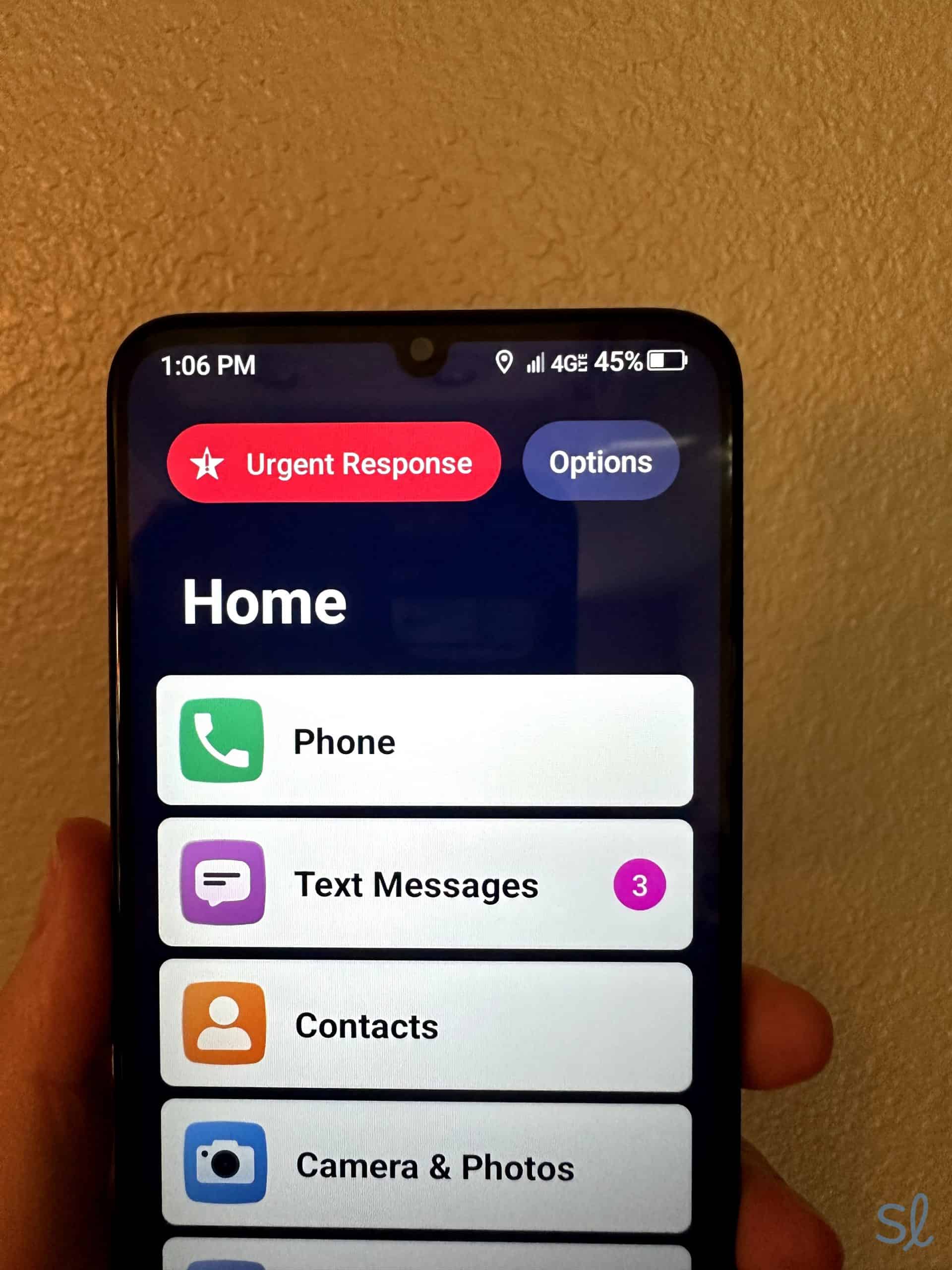
Lively's Urgent Response button is clearly displayed on the home and lock screen
Do Seniors With Dementia Need a Cell Phone?
Depending on the stage of their illness, seniors with memory loss can benefit from a cell phone — for several reasons. Having a mobile phone handy gives older folks with difficulties remembering things more independence. They can call for help if there’s an emergency or whenever they have a foggy moment. Older adults with dementia can also use GPS navigation features to find their way home if they wander.
Most importantly, cell phones make it easier for loved ones to stay in touch. This is probably the best reason for older adults with memory loss to have a phone, even if they don’t plan to use many of the features. Studies have shown that just 10 minutes of social contact a day can improve an older adult’s quality of life substantially.3
» Learn More: Statistics About Seniors
With GPS tracking, family members and caregivers can locate loved ones quickly if they go missing or get lost. Many cell phones for seniors also come with medical alert or emergency response features — and for good reason. Approximately 70 percent of seniors with dementia experience a fall every year,3 so monitoring features such as an SOS button, fall detection, and activity tracking can be lifesavers.
Many cell phones for those with dementia, including the Jitterbug Smart4, offer GPS tracking features for family members and caregivers
What to Consider When Shopping for a Dementia-Friendly Cell Phone
Just because a phone is senior-friendly doesn’t mean it will be the right choice for an older adult with dementia. Here are a few things to consider when choosing a dementia-friendly cell phone:
- Stage of dementia: Dementia is a degenerative disorder, which means it will generally get worse with time. Seniors who have relatively mild or early stage dementia may feel comfortable navigating a smartphone, while seniors with advanced dementia may just need a basic cell phone for emergencies.
- Caregiver presence: The availability of caregivers is a very important factor to consider when purchasing a cell phone for someone with dementia. If there is a dependable caregiver who can provide ongoing support, it can be extremely beneficial to pick a phone that lets caregivers have more control over settings, contacts, and phone usage.
- Budget: The cost of a cell phone for seniors with dementia can be a double-edged sword. On the one hand, you may want to spend more to get a phone that has a lot of dementia-friendly features. On the other hand, if your loved one has a history of losing phones, you may prefer to invest in a cheaper option. Either way, you’ll want to consider your long-term phone budget before making a purchase.
- Emergency service features:Just about every phone can dial 911, but that may not be enough for seniors with dementia. Additional features, such as an SOS button, fall detection, and 24/7 emergency monitoring services, are just some of the things to look for. If your loved one dials 911 frequently or in situations in which it isn’t necessary, you may also consider features that reroute 911 calls to a trained agent who knows your loved one has dementia and can evaluate the situation accordingly.
FYI: If you’re looking for a phone on a tight budget, check out our guide to the best cheap cell phones for seniors!
More Cell Phone Resources for Seniors
If you’re looking for a certain type of cell phone or you just want to compare all the options, check out our resources below. We’ve tested, compared, and ranked cell phones for a variety of needs.
Frequently Asked Questions About Cell Phones for Seniors With Dementia
-
Can seniors with dementia use a cell phone?
Yes. Seniors with dementia can learn how to use a cell phone with some practice. But the device has to be easy to use. Caregivers should make sure privacy settings are in place to protect against common forms of senior fraud, such as spam emails, fake websites, and robocalls.
-
How much do cell phones for seniors with dementia cost?
Based on our research, a quality phone with the right features to keep seniors living with memory loss safe ranges from $75 to $349.
-
Do the cell phones on this list require a contract?
Many of these phones are available through cellular carriers, but we purposely chose models without contracts for optimal flexibility.
-
Should seniors with dementia have internet access on their phones?
Absolutely. Even if they’ve reached a stage where they can’t surf by themselves, caregivers and loved ones can help them access emails, photos, and videos from family members.
-
Do any of these phones have discounts for seniors?
Yes. Most of the carriers that offer the phones on our list have discounted rates specifically for seniors.
-
What is the best mobile phone for someone with dementia?
The Jitterbug Smart4 is the best all-around mobile phone for seniors with dementia. It offers simple list-style menus, all the features you’d expect with a basic smartphone, and even medical alert features if you opt for one of Lively’s top-tier plans.
Alzheimer's Society. (2021). Staying connected to the people who matter to you after a dementia diagnosis.
Drexel News. (2023). Fall Rate Nearly 50% Among Older Americans with Dementia.
AARP. (2018). Just an Hour a Week of Social Interaction Helps Dementia Patients.
ScienceDirect. (2018). “Text It” program to track falls in patients with Alzheimer's disease and dementia.





